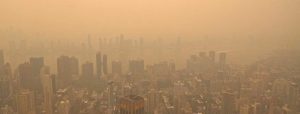World
Health Organisation (WHO) recommended that restricting air pollution to levels
could stop more than 50,000 deaths in Europe yearly and therefore called for
urgent action, as per a research published on Wednesday. The WHO evaluated that
above seven million people are killed every year by air pollution and is one of
the major reason for sickness and absenteeism across the globe.
Cities, with their crowded streets and high energy use, are hotspots for
illness and disease linked to air pollution. The WHO recommends that fine
particulate matter (PM2.5) not exceed 10 milligrammes per cubic metre of air,
averaged annually. For nitrous oxide (NO2), the threshold not to be exceeded is
40 mg/m3, reported AFP.
The study which was published in the Lancet Planetary Health journal,
evaluated that these two pollutants among 1,000 European cities cause the early
death burden while bringing down PM2.5 and No2 to safe WHO levels could stop
51,213 early deaths annually, the study added.
The authors of the study also said, it is recorded that if air pollution
were reduced to the lowest then it could prevent around 125,000 deaths yearly.
Also read: World ‘on brink of catastrophic moral failure’: WHO questions uneven COVID-19 vaccine distribution
Mark Nieuwenhuijsen of the Barcelona Institute for Global Health
(ISGlobal) said the research “proves that many cities are still not doing
enough to tackle air pollution. Levels above WHO guidelines are leading to
unneccessary deaths.”
The researchers also formed a “mortality burden score” after combining the
city-centric data on air pollution models with mortality numbers that ranked
each cities from best to worst, reported AFP.
Air pollution causing deaths varied widely, with Madrid recording NO2
levels which eventually resulted in 7% deaths yearly. Several cities of PO-Valley region of
northern Italy, Poland, and the Czech Republic recorded the highest
mortality burden, while the Italian cities of Brescia, Bergamo and Vicenza were
among the top five cities for PM2.5 concentrations.
Also read: Experts report slow approach from WHO, China during initial stages of pandemic
Tromso in Norway, Umea in Sweden, Oulu in Finland, and the
Icelandic capital Reykjavik recorded the lowest mortality burden.
The study found that on average, 84 percent of the population in cities
studied were exposed to PM2.5 levels above the WHO guideline while nine percent
were exposed to higher-than-recommended NO2 levels.





